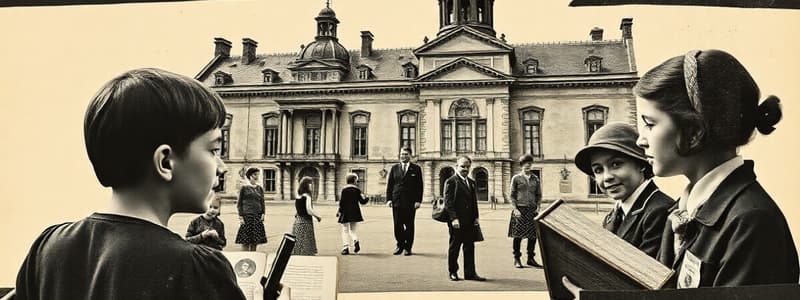Podcast
Questions and Answers
What is the structure of education and training systems focused on in this report?
What is the structure of education and training systems focused on in this report?
- From pre-primary to tertiary level (correct)
- Only primary education
- Only secondary education
- Only post-tertiary education
How many education systems are covered in this report?
How many education systems are covered in this report?
- 37
- 34
- 39 (correct)
- 27
Which model of education allows students to follow a common curriculum throughout compulsory education?
Which model of education allows students to follow a common curriculum throughout compulsory education?
- Differentiated lower secondary education
- Common core curriculum provision
- Tertiary education model
- Single structure education (correct)
What happens to students after completing primary education in a common core curriculum provision model?
What happens to students after completing primary education in a common core curriculum provision model?
What is the purpose of the guide included in the report?
What is the purpose of the guide included in the report?
Which type of education model involves transitioning between primary and lower secondary education?
Which type of education model involves transitioning between primary and lower secondary education?
What does ISCED stand for in the context of this report?
What does ISCED stand for in the context of this report?
What is the role of the European Education and Culture Executive Agency mentioned in the document?
What is the role of the European Education and Culture Executive Agency mentioned in the document?
What is the starting age for Krippen in Belgium?
What is the starting age for Krippen in Belgium?
Which type of education follows after Vysoká škola in Czechia?
Which type of education follows after Vysoká škola in Czechia?
In which European country is the Detska yasla associated with early childhood education?
In which European country is the Detska yasla associated with early childhood education?
What age range does the programme 'Folkeskole / Grundskole' cover in Denmark?
What age range does the programme 'Folkeskole / Grundskole' cover in Denmark?
Which level of education is directly followed by Gymnasium in Germany?
Which level of education is directly followed by Gymnasium in Germany?
What is the equivalent of tertiary education in Bulgaria?
What is the equivalent of tertiary education in Bulgaria?
How many years does the programme usually last for the Dětská skupina in Czechia?
How many years does the programme usually last for the Dětská skupina in Czechia?
What is a feature of KSO in the Czech education system?
What is a feature of KSO in the Czech education system?
Which age is the legal requirement for starting school in Denmark?
Which age is the legal requirement for starting school in Denmark?
Which educational institution is aligned with higher vocational education in Denmark?
Which educational institution is aligned with higher vocational education in Denmark?
In Germany, what stage comes after the Grundschule?
In Germany, what stage comes after the Grundschule?
What is the highest level of education available in Bulgaria?
What is the highest level of education available in Bulgaria?
What is the age for starting primary education in Czechia?
What is the age for starting primary education in Czechia?
What type of education does the Istituto tecnologico superiore now offer?
What type of education does the Istituto tecnologico superiore now offer?
Which age group is associated with the early childhood education programmes in Cyprus?
Which age group is associated with the early childhood education programmes in Cyprus?
Which ISCED level corresponds to primary education in Cyprus?
Which ISCED level corresponds to primary education in Cyprus?
Compulsory full-time education in Cyprus is represented under which ISCED levels?
Compulsory full-time education in Cyprus is represented under which ISCED levels?
What educational stage follows secondary general education in Latvia?
What educational stage follows secondary general education in Latvia?
What is the primary educational structure referred to as 'Gimnazija' in Lithuania?
What is the primary educational structure referred to as 'Gimnazija' in Lithuania?
In Latvia, what does 'Pirmsskolas izglītības iestāde' refer to?
In Latvia, what does 'Pirmsskolas izglītības iestāde' refer to?
Which country is mentioned with a wide age range for different educational stages?
Which country is mentioned with a wide age range for different educational stages?
What programme length does 'Techniki' in Cyprus refer to?
What programme length does 'Techniki' in Cyprus refer to?
In Lithuania, what is the 'Kolegija' known for?
In Lithuania, what is the 'Kolegija' known for?
At which ISCED level are vocational education institutions categorized in Latvia?
At which ISCED level are vocational education institutions categorized in Latvia?
What does 'Dimosies Scholes Tritovathmias Ekpaidefsis' refer to in Cyprus?
What does 'Dimosies Scholes Tritovathmias Ekpaidefsis' refer to in Cyprus?
What level of education is 'Pirmsskolas izglītības iestāde' associated with in Latvia?
What level of education is 'Pirmsskolas izglītības iestāde' associated with in Latvia?
What is the requirement for students under 18 who have completed compulsory education but dropped out?
What is the requirement for students under 18 who have completed compulsory education but dropped out?
Which level corresponds to primary education in the ISCED classification?
Which level corresponds to primary education in the ISCED classification?
What type of education is provided by public education authorities in early childhood education and care?
What type of education is provided by public education authorities in early childhood education and care?
What does ISCED stand for?
What does ISCED stand for?
Which of the following is not classified under post-secondary non-tertiary education?
Which of the following is not classified under post-secondary non-tertiary education?
At what age does full-time compulsory education typically start?
At what age does full-time compulsory education typically start?
Which educational structure specifically focuses on the combination of school and workplace courses?
Which educational structure specifically focuses on the combination of school and workplace courses?
Which level of the ISCED classification does represent tertiary education?
Which level of the ISCED classification does represent tertiary education?
What type of education does MBO (Middenkaderopleiding) refer to?
What type of education does MBO (Middenkaderopleiding) refer to?
Which educational institution corresponds to higher education in Malta?
Which educational institution corresponds to higher education in Malta?
Which of the following best describes the phase out of compulsory work experience?
Which of the following best describes the phase out of compulsory work experience?
What is the primary focus of the Dutch educational structure?
What is the primary focus of the Dutch educational structure?
Which level of ISCED represents secondary general education?
Which level of ISCED represents secondary general education?
What is the age range typically associated with higher secondary schools in Malta?
What is the age range typically associated with higher secondary schools in Malta?
What is the primary focus of Agrupamentos de Escolas?
What is the primary focus of Agrupamentos de Escolas?
What education level is NOT included in the Romanian education system as per the content?
What education level is NOT included in the Romanian education system as per the content?
Which of the following accurately describes the structure of education in Slovenia?
Which of the following accurately describes the structure of education in Slovenia?
Which statement about ISCED levels in the educational system is TRUE?
Which statement about ISCED levels in the educational system is TRUE?
In which type of school do students typically begin their education in Romania?
In which type of school do students typically begin their education in Romania?
Which of the following is NOT mentioned as part of the Slovakian education system?
Which of the following is NOT mentioned as part of the Slovakian education system?
What characterizes Școală profesională in Romania?
What characterizes Școală profesională in Romania?
How long is the typical program duration for primary education in Romania?
How long is the typical program duration for primary education in Romania?
Which educational level comes after Gimnazija in Slovenia?
Which educational level comes after Gimnazija in Slovenia?
Which type of school in Slovenia focuses primarily on vocational education?
Which type of school in Slovenia focuses primarily on vocational education?
What is a key feature of early childhood education as described?
What is a key feature of early childhood education as described?
What type of school is 'Școală postliceală' in Romania?
What type of school is 'Școală postliceală' in Romania?
What age group does the 'Creșă' serve in Romania?
What age group does the 'Creșă' serve in Romania?
Flashcards are hidden until you start studying
Study Notes
Organizational Models of Primary and Lower Secondary Education
- European education systems typically have compulsory education from pre-primary to lower secondary level.
- Three main organizational models for primary and lower secondary education (ISCED levels 1 and 2) are identified:
- Single structure education: All students follow a common curriculum from the start of compulsory education until its completion.
- Common core curriculum provision: After completing primary education (ISCED level 1), all students move to lower secondary education (ISCED level 2) where they follow a shared curriculum.
- Differentiated lower secondary education: Students are directed to different secondary education pathways based on their interests or academic abilities.
Guide to Reading the Diagrams
- The diagrams represent the structure of education systems in 39 countries participating in the Erasmus+ program.
- The scope of the diagrams covers pre-primary to tertiary education.
- Main Elements:
- Age of Students: Represented on the horizontal axis, ranging from 0 to 22 years old.
- Programme Duration (Years): Represented on the vertical axis, indicating the number of years spent in each education stage.
- Key: Explains the symbols used for each education level.
- ISCED 2011: International Standard Classification of Education, used to categorize education levels.
Key
- Compulsory full-time education: Full-time education that is required by law.
- Possible additional year: An optional extra year of education.
- Study abroad: Option to study in a different country.
- Compulsory work experience: Required work experience after completing education.
Overview of European Education Systems
- The text provides a brief overview of the education systems in Cyprus, Latvia Lithuania, Malta and the Netherlands, focusing on how these systems align with the International Standard Classification of Education (ISCED) framework.
Cyprus
- The Cypriot education system primarily follows a 6+3+3 structure:
- 6 years of primary education (ISCED 1)
- 3 years of lower secondary (ISCED 2)
- 3 years of upper Secondary (ISCED 3)
- The system also features:
- Early childhood education (ISCED 0)
- Vocational education (ISCED 4)
- Tertiary education (ISCED 5 and 6)
- Further education and training (ISCED 7)
- Tertiary education in Cyprus is primarily offered by universities (Panepistimia) and post-secondary vocational institutes (Metalykeiaka Instituta Epaggelmatikis)
- The system is currently undergoing changes related to ISCED 5 and 6 programs, though the specific details and implementation are still under development.
Latvia
- The Latvian education system has an 11-year structure that includes:
- Pre-primary education (ISCED 0)
- Primary education (Sākumskola, ISCED 1)
- Basic education (ISCED 2) (divided into Pamatskola and Vidusskola)
- Upper secondary education (ISCED 3): Students can opt for Gymnasium or vocational education.
- Tertiary education (ISCED 5 and 6)
- Latvian students under 18 who leave schooling without completing any other qualifications are required to continue their education and training until they obtain at least one partial VET qualification.
Lithuania
- The Lithuanian education system consists of:
- Pre-primary education (Ikimokyklinio ugdymo mokykla, ISCED 0)
- Primary education (Pradinė mokykla, ISCED 1)
- Basic education (ISCED 2): Includes Progimnazija, and Pagrindinė mokykla options.
- Upper secondary education (Gimnazija, ISCED 3)
- Tertiary education (ISCED 5 and 6)
- The Lithuanian education system is somewhat flexible, allowing for students to choose between different pathways within the basic and upper secondary levels.
- Students who have not completed compulsory education nor hold a qualifying certification (by age 18) are required to continue their education and training till they obtain a relevant qualification.
Malta
- The Maltese education system follows a 5+4+3 (or 8+5) educational structure (ISCED 1, 2, 3, 4 respectively), alongside several institutions of higher education:
- University of Malta
- Malta College of Arts, Science and Technology (MCAST)
- Institute of Tourism Studies (ITS)
- The Maltese system includes early childhood education (ISCED 0) and post-secondary non-tertiary education, as well as tertiary education and training.
Netherlands
- The Dutch education system features a unique structure with:
- Pre-primary education (ISCED 0)
- Primary education (ISCED 1)
- Secondary education (ISCED 2 & 3)
- Voorgezet onderwijs (VWO) : Preparatory for university (ISCED 3)
- Voorgezet onderwijs (HAVO) : Leads to HBO (higher professional education) - ISCED 4
- Voorgezet Onderwijs (VMBO): Vocational secondary education (ISCED 3)
- Tertiary education (ISCED 5 and 6) consists of:
- Wo (bachelor) and (master) : Academic education
- HBO (bachelor) and (master): Higher professional education
- MBO: Vocational education (includes various levels: Entree, Basisberoeps, Vakopleiding, Middenkader)
- Specialistenopleiding: Specialized education programs
- The Dutch system also includes Praktijkonderwijs (practical education) within the secondary level.
Educational Systems: Romania, Slovenia, and Slovakia
- Agrupamentos de Escolas are organizational units that encompass multiple schools within a learning cycle, from kindergarten to upper secondary education.
- The diagram illustrates different learning spaces for each type of education but does not represent all existing educational institutions in Portugal.
- Romania's educational system:
- Creșă (nursery): 0 - 3 years of age
- Grădiniță (kindergarten) : 3 - 6 years of age
- Școală primară (primary school): 6 - 14 years of age
- Școală Gimnazială (lower secondary school): 14 - 18 years of age
- Liceu (upper secondary school): 18 - 20 years of age
- Liceu filiera Teoretică (theoretical upper secondary school): 18 - 20 years of age
- Liceu filiera Vocațională (vocational upper secondary school): 18 - 20 years of age
- Liceu filiera Tehnologică (technological upper secondary school): 18 - 20 years of age
- Școală profesională (vocational school) : 18 - 20 years of age
- Școală profesională în sistem dual (dual vocational school): 18 - 20 years of age
- Școală postliceală (post-secondary school) : 18 - 20 years of age
- Școală postliceală în sistem dual (dual post-secondary school): 18 - 20 years of age
- Școală de maiștri (school for masters): 18 - 20 years of age
- Slovenia's educational system:
- Vrtec (kindergarten) : 0 - 6 years of age
- Osnovna šola (primary school) : 6 - 15 years of age
- Gimnazija (upper secondary school): 15 - 19 years of age
- Univerza (university): 19 - 23 years of age
- Visokošolski zavod (higher education institution): 19 - 23 years of age
- Višja strokovna šola (higher vocational school) : 19 - 23 years of age
- Srednja poklicna in strokovna šola (secondary vocational school): 15 - 19 years of age
- Slovakia's educational system:
- Primary school: 6 - 15 years of age
- Secondary general education : 15 - 19 years of age
- Secondary vocational education: 15 - 19 years of age
- ISCED levels:
- ISCED 0: Early childhood education and care (not under public education authorities)
- ISCED 1: Early childhood education and care (under public education authorities)
- ISCED 2: Primary education
- ISCED 3: Lower secondary education
- ISCED 4: Upper secondary education
- ISCED 5: Post-secondary non-tertiary education
- ISCED 6: Tertiary education (full-time)
- ISCED 7: Tertiary education (part-time)
Studying That Suits You
Use AI to generate personalized quizzes and flashcards to suit your learning preferences.




